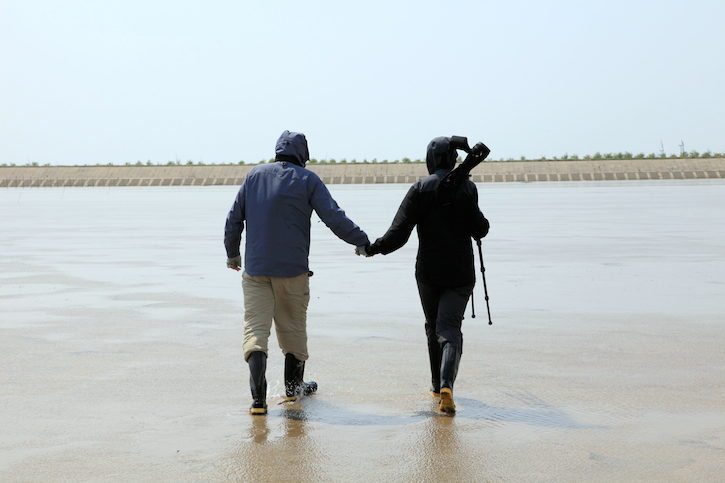
By Jianbin Shi
At the Tiaozini mudflat in Jiangsu province, Hank Paulson, former Secretary of the U.S. Treasury, China expert, and founder of the Paulson Institute, and his wife Wendy braced themselves against chilly, salty winds as they walked toward the tide lines. They had come to experience firsthand the annual epic migration of shorebirds along the Yellow Sea coast. On a visit to Rudong with a similar objective two years earlier, torrential rain and wind had rendered the experience downright miserable. On that trip, the pair had hoped to see the critically endangered spoon-billed sandpiper that refuels in Chinese coastal wetlands on its journey from Southeast Asia to Siberia, where it breeds. With the help of expert local guides, they were able to catch a momentary glimpse of one, but it was hardly a satisfying experience.
This time was different. The Paulsons, life-long bird watchers and conservationists, saw several spoon-billed sandpipers in good light with clear visibility. More impressively, they stood amid tens of thousands of other migratory shorebirds, including bar-tailed godwit, Eurasian and Far Eastern curlew, common greenshank, and red-necked stint, which feed and stage here. They were amazed. Wendy called it one of the greatest wildlife migration spectacles on the planet. Her husband said, “It is rare even globally to see so many species and numbers of water birds at a single site.” He added that the experience enabled him to truly understand the significance of the mudflat to many migratory water birds, and strengthened his resolve to conserve these coastal wetlands.
The Paulsons had timed their April Jiangsu visit to coincide with the season when migratory water birds stage and refuel in the coastal wetlands along the Yellow Sea before they fly to their far northern breeding sites. The trip’s purpose was not only to witness the birds in Rudong and Dongtai, but more importantly for Hank Paulson to meet with top officials of the province and Yancheng Municipality to discuss conservation efforts, and then to share what he learned with senior officials in Beijing.

Why Jiangsu? The province is home to more than 980 km of coastline and nearly one million hectares of coastal wetlands. Its intertidal mudflats, one of the largest remaining in Asia, are situated along the East Asian-Australasian Flyway, serving as a key staging site and energy refueling station for many rare and endangered species of water birds. The critically endangered spoon-billed sandpiper, with a global population of fewer than 500, depends on these flats. More than 140 individuals of spoon-billed sandpiper have been recorded to stage and molt in Rudong and Dongtai in Jiangsu.
Jiangsu’s coastal mudflats are essential to the conservation of endangered species such as spoon-billed sandpipers and red-crowned cranes. In addition they provide priceless ecosystem services, such as supporting and maintaining rich biodiversity, mitigating threats from natural disasters, and purifying water quality. Four coastal wetlands in Jiangsu, together with seven coastal wetland sites in other provinces, were defined by the Blueprint Project of Coastal Wetland Conservation and Management in China as key habitats that urgently need to be conserved. (The Jiangsu wetlands are: Rudong mudflat in Nantong, Tiaozini mudflat in Dongtai of Yancheng, the coastal wetlands in Lianyungang, and Ganyu mudflats in Lianyungang.) The Blueprint Project, with financial support from Lao Niu Foundation, was implemented by the Paulson Institute, the Convention on Wetlands Management Office, People’s Republic of China, and the Institute of Geographic Sciences and Natural Resources Research, Chinese Academy of Sciences.
Following completion of the Blueprint Project, Paulson wrote to the former Party Secretary of Jiangsu, aiming to draw the Jiangsu provincial government’s attention to the enhanced protection of the four wetland sites in Jiangsu. On the trip to Jiangsu this April, Paulson’s first stop in China was Nanjing, Jiangsu’s capital, to meet Li Qiang, the incumbent Party Secretary, for a discussion of provincial sustainable development and wetlands conservation.
During the meeting, Party Secretary Li introduced the general condition of Jiangsu, which has a high GDP and large population, but small land area. He explained that economic growth in the province is constrained by limited natural resources. Li also talked about the problems facing Jiangsu’s coastal wetlands, in particular the threat from Spartina grass (Spartina alterniflora). The wetland grass is an invasive species that was introduced to facilitate land reclamation, but now is destroying huge swathes of wetland ecosystems. Paulson presented the findings of the Blueprint Project, reiterating the significance of the four coastal wetland sites in Jiangsu and the urgency of conserving them. The Paulson Institute is working with Chinese government agencies to develop a pilot project on the prevention and control of Spartina grass in China.
Following the Tiaozini wetland visit, Wendy Paulson headed to Shenzhen to meet with the Mangrove Wetlands Conservation Foundation, while Hank Paulson went to Yancheng to meet with its Party Secretary, Wang Rongping. They discussed coastal wetland protection, sustainable urbanization, the nomination of world heritage sites, and the promotion of wetland resources in Yancheng. Paulson shared his experience of watching shorebirds in Tiaozini and reiterated the key ecological values of Tiaozini mudflat and its international significance to migratory water birds along the East Asian-Australasian Flyway. They agreed on the serious damage caused by Spartina grass to Jiangsu’s coastal wetlands and the urgency of preventing and controlling the alien species. Both sides expressed interest in working together on a pilot project to control Spartina grass in Yancheng. Finally, both sides agreed to cooperate to protect the coastal wetlands in Yancheng, apply for world heritage designation, promote wetland resources in Yancheng, and apply for the Paulson Prize for Sustainable Cities Project.



